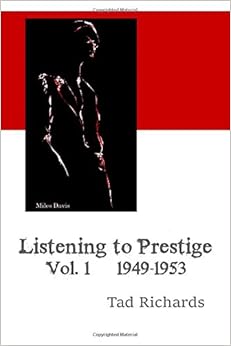And here, for one track, is the tenor player Miles hired when he couldn't get Sonny. These are two young men who are poised to become the dominant tenor saxophone players in jazz, the heirs apparent to Coleman Hawkins, Ben Webster and Lester Young.
I realized, as I wrote that, that I had never been quite sure what "heir apparent" meant, so I looked it up. An heir apparent is the next in line for succession to a throne or a title, and is next in line no matter what. This is distinguished from an heir presumptive, who is next in line until someone comes along with a better claim. So in jazz, one would have to say that all heirs are heirs presumptive--they are one cutting contest away from being displaced as next in line to the throne. For that matter, jazz royalty are kings presumptive.
But these were the two, and time and history have moved them from presumptive to apparent to jazz royalty, and this one track, from this one recording session, is their only appearance on record together. Ever.
The tune is "Tenor Madness," and it has become a jazz standard...and not just for tenor players. On YouTube, you can find amazing renditions of it by Emily Remler and Toots Thielemans. Tenor players who have recorded it include Arnett Cobb and Joe Henderson, Dexter Gordon, Joe Lovano and George Adams, Eddie Harris--and if you're learning jazz saxophone, you'll learn this.
Sonny and Trane are truly heirs presumptive on this recording. I wrote about the seamless weaving together of solos by Coltrane, Donald Byrd and Hank Mobley on the Elmo Hope session of a few weeks earlier. Not so here. These guys are kicking each other, challenging each other, every step of a twelve-minute journey, and the winner...well, the listener, for a start. But also both sax men. They both emerge triumphant. Wikipedia quotes jazz critic Dan Krow as saying that "the two complement each other, and the track does not sound like a competition between the two rising saxophonists," and that's sort of true, in that there are no losers. Turns out they both really are heirs apparent, if not royalty already.
 |
| On the left, the Prestige cover. On the right, the British Esquire label cover, far more imaginative. The cover design is credited to Sherlock, about whom I can find nothing. |
The rest of the session is Rollins and the rhythm section. The music is completely different, but no less rewarding: a thoughtful, delicate jazz impression of a piece by impressionist composer Claude Debussy. Rollins is outstanding on it; so are Garland and Chambers, in their solos. Rodgers and Hart's "The Most Beautiful Girl in the World" is kicked harder, and gives Philly Joe Jones some space to swing, and has a particularly nifty closing statement of the melody by Rollins.
"Paul's Pal" is a Rollins composition, and unsurprisingly enough, gives a showcase to Paul Chambers. But Sonny also shows what a pal he is by playing one part in such a low register that he's nearly down there with the bass. He also proves to be a pretty good pal to Garland and Jones. This is a true quartet session, with everyone getting solo space, and everyone contributing to the whole experience.
Tenor Madness became the title of the album. It's on lots of lists of greatest jazz albums of all time--mostly for the title track, but even without it, the album would rank way up there.



No comments:
Post a Comment